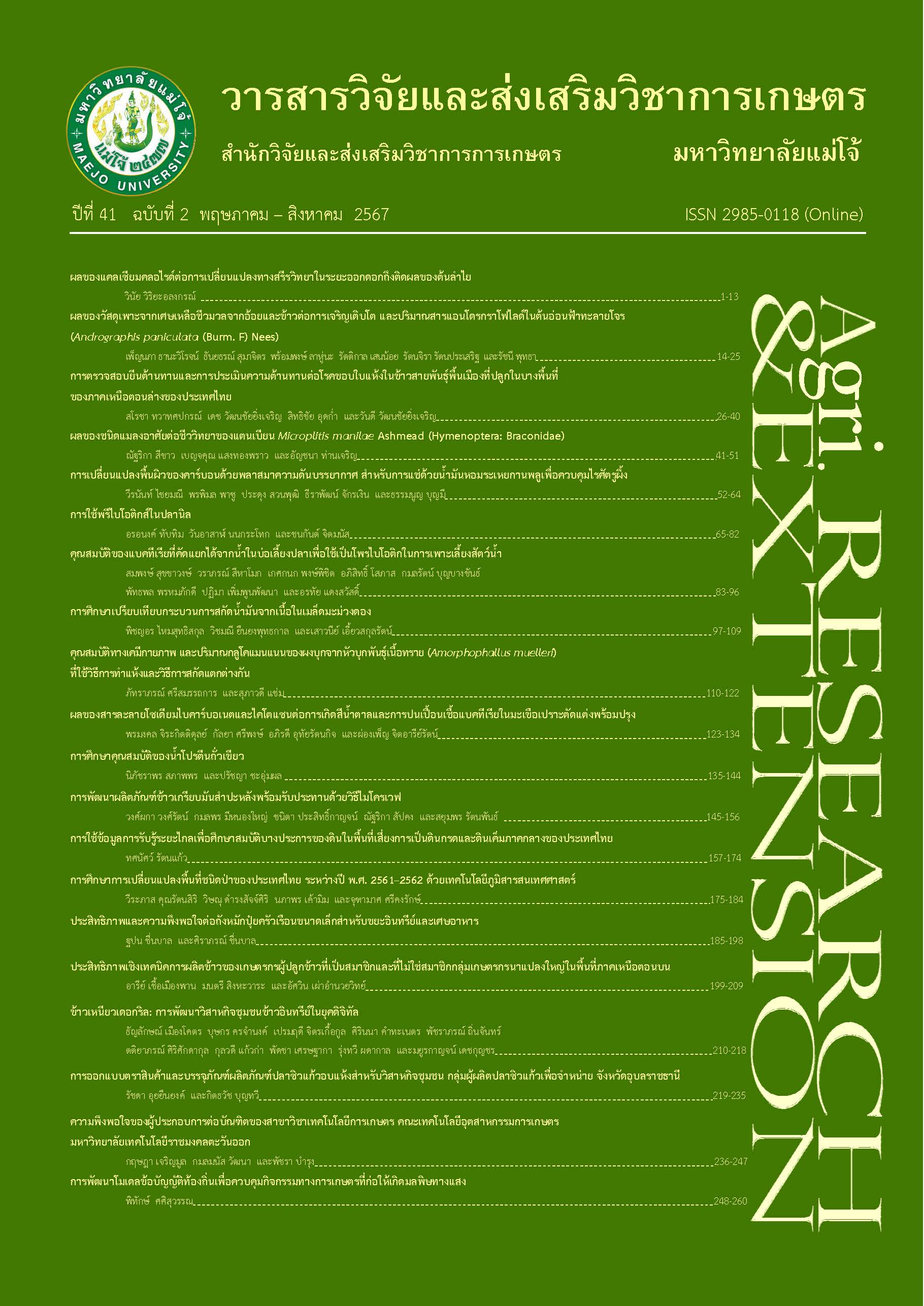การศึกษาคุณสมบัติของน้ำโปรตีนถั่วเขียว
DOI:
https://doi.org/10.14456/jare-mju.2024.31คำสำคัญ:
โปรตีนถั่วเขียว, การทำแห้งแบบแช่เยือกแข็ง, การฉายรังสีบทคัดย่อ
การศึกษาคุณสมบัติของน้ำโปรตีนถั่วเขียวซึ่งเป็นของเหลือทิ้งจากกระบวนการผลิตวุ้นเส้น เป็นส่วนที่ได้หลังจากขั้นตอนการสกัดแป้งถั่วเขียว ของเหลือทิ้งนี้ถูกนำมาทำให้เป็นผงแห้งโดยวิธีการแช่เยือกแข็ง (Freeze drying) จากนั้นตัวอย่างผงแห้งถูกนำมาวิเคราะห์ปริมาณสารอาหารและกรดอะมิโน พบว่าอุดมไปด้วยสารอาหารมากมาย ส่วนใหญ่เป็นโปรตีนเท่ากับ 62.05 g/100g มีกรดอะมิโนจำเป็นปริมาณมาก เช่น ไลซีน ฟีนิลอะลานีน และลิวซีน อยางไรก็ตามโปรตีนถั่วเขียวพบปนเปื้อนจุลินทรีย์ในปริมาณมาก จึงนำผงโปรตีนไปฉายรังสี เพื่อลดปริมาณจุลินทรีย์ปนเปื้อน และทำการวิเคราะห์ค่าปริมาณจุลินทรีย์ปนเปื้อนอีกครั้ง หลังการฉายรังสีพบปริมาณจุลินทรีย์ลดลงอยู่ในระดับที่ปลอดภัยต่อผู้บริโภค ทำการระบุชื่อเชื้อจุลินทรีย์ที่พบด้วยวิธีทางชีวโมเลกุล พบว่าไม่มีเชื้อก่อโรค
เอกสารอ้างอิง
Bayer, C., H. Bernard, R. Prager, W. Rabsch, P. Hiller, B. Malorny, B. Pfefferkorn, C. Frank, A. de Jong, I. Friesema, K. Stark, and Bm. Rosner. 2014. An outbreak of Salmonella Newport associated with mung bean sprouts in Germany and The Netherlands, October to November 2011. Eurosurveillance 19(1): 20665. DOI: 10.2807/15607917.es2014.19.1.20665
Brishti, F.H., S.Y. Chay, K. Muhammad, M.R. Ismail-Fitry, M. Zarei, S. Karthikeyan, and N. Saari. 2020. Effects of drying techniques on the physicochemical, functional, thermal, structural and rheological properties of mung bean (Vigna radiata) protein isolate powder. Food Research International 138: 1-13.
Dahiya, P.K., AR. Linnemann, M.A.J.S. Van Boekel, N. Khetarpaul, R.B. Grewal and M.J.R. Nout. 2015. Mung bean: technological and nutritional potential. Critical Reviews in Food Science and Nutrition 55(5): 670-688. DOI: 10.1080/10408398.2012.671202.
Hung, P.V., N.T.H. Yen, N.T.L. Phi, N.P.H. Tien, N.T.T. Trung. 2020. Nutritional composition, enzyme activities and bioactive compounds of mung bean (Vigna radiate L.) germinated under dark and light conditions. Lebensmittel-Wissenschaft & Technologie 133: 1-8.
Lacumin, L., F. Ginaldi, D. Andyanto, and C. Giuseppe. 2017. Microbial quality of raw and ready-to-eat mung bean Srouts Produced in Italy. International Journal of Food Sciences and Nutrition. 3(1): 555601. DOI: 10.19080/NFSIJ.2017.03.555601
Mubarak, A.E. 2005. Nutritional composition and antinutritional factors of mung bean seeds (Phaseolus aureus) as affected by some home traditional processes. Food Chemistry 89: 489-495.
Nagar, V., L.P. Godambe and R. Shashidhar. 2016. Development of microbiologically safe mung bean sprouts using combination treatment of sodium hypochlorite and gamma radiation. International Journal of Food Science and Technology 51: 595-601.
Park, H., P. Puligundla and C. Mok. 2020. Microbial decontamination of mung bean sprouts using electrolyzed water and its effects on the physicochemical and sensory properties of the sprouts. Chiang Mai Journal of Science 47(1): 28-38.
Peles, F. Z. Győri, T. Bácskai, Zs. Szabó, M. Murvai, B. Kovács. 2012. Microbiological quality of organic wheat grains and sprout. Analele Universitatii din Oradea, Fascicula Protectia Mediului XVIII: 53-60.
Prokopowich, D. and G. Blank. 1991. Microbiological evaluation of vegetable sprouts and seeds. Journal of Food Protection 54(7): 560-562.
Tang, D., Y. Dong, H. Ren, L. Li, and C. He. 2014. A review of phytochemistry, metabolite changes, and medicinal uses of the common food mung bean and its sprouts (Vigna radiata). Chemistry Central Journal 8(1): 1752-1753.
ดาวน์โหลด
เผยแพร่แล้ว
รูปแบบการอ้างอิง
ฉบับ
ประเภทบทความ
สัญญาอนุญาต
ลิขสิทธิ์ (c) 2024 วารสารวิจัยและส่งเสริมวิชาการเกษตร

อนุญาตภายใต้เงื่อนไข Creative Commons Attribution-NonCommercial-NoDerivatives 4.0 International License.
บทความนี้ได้รับการเผยแพร่ภายใต้สัญญาอนุญาต Creative Commons Attribution-NonCommercial-NoDerivatives 4.0 International (CC BY-NC-ND 4.0) ซึ่งอนุญาตให้ผู้อื่นสามารถแชร์บทความได้โดยให้เครดิตผู้เขียนและห้ามนำไปใช้เพื่อการค้าหรือดัดแปลง หากต้องการใช้งานซ้ำในลักษณะอื่น ๆ หรือการเผยแพร่ซ้ำ จำเป็นต้องได้รับอนุญาตจากวารสาร





